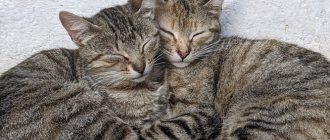How does a cat punish her kittens?
Sometimes owners can observe how a cat “punishes” a kitten by grabbing it with its front paws and hitting it with its hind paws, as well as biting it in the neck area. Although this behavior may seem aggressive from the outside, in fact, it is not a punishment: this is how cats teach kittens to hunt - to grab, hold and kill prey.
Interesting materials:
What holiday is February 18, 2021 in Ukraine? Which premium tank should I get in 2021? Which processor is best for cs go? What is the cost of living in the Amur region in 2021? What is the cost of living in Omsk for 2021? What year is it now according to the Gregorian calendar? What year is it now according to the Slavic calendar 2021? What year is it now according to the eastern horoscope? What series lasted 72 years? What is the fine for driving without a license in 2021?
Causes
- Anger . Anger may be the most obvious reason for a cat to growl. Frustrated and angry cats may express their emotions by growling. When your cat doesn't want to be put in his crate, he may respond by growling. He may growl at you if you try to touch him or move him when he doesn't want to be moved.
- Aggression . Aggression and anger are closely related, but aggression is worth talking about separately because cats become aggressive for many reasons. The two main ways a cat may growl at you or another cat can be related to non-recognition aggression and possessive aggression (or dominance aggression). Rejection aggression occurs when a cat was previously familiar with a person or other animal, but because they have been away for a while, the cat no longer recognizes the outgoing party.
- Fear . Cats do not always growl from a defensive position. Sometimes they do this to show that they are confused or scared. This can happen when a stranger enters your home who has never been there before. A growling cat in this situation does not know what to do with the new thing, so it growls.
- Pain . If your cat growls alone and does not exhibit aggressive or fearful body language, she may be suffering from physical pain. Some cats growl when they are experiencing internal pain that you can't see, such as a urinary tract infection or aching teeth. Your cat may be communicating to you that she is in pain through this behavior.
- Moderate irritation . Sometimes cats that growl frequently are simply saying that they don't like something. Your cat may growl when the veterinarian checks teeth during an exam, trims nails, or takes his temperature. Some cats are easier to irritate than others. This will largely depend on the individual and their background.
Image Credit: Fang_Y_M, Pixabay
Cats fight, although they used to be friends. What to do?
Sudden enmity between cats that previously lived peacefully is one of the most common reasons for seeking help from animal psychologists.
The reason for the enmity is fear, which is associated with the other cat. Here are two illustrative examples: 1) An old cat was sleeping on the nightstand, a young cat was sitting next to her and washing herself. The hostess came and turned on the TV. Somehow it turned out that the TV was set to maximum volume and it literally roared. The old cat jumped in place and the first thing she saw was a young cat. She, frightened by both the sound and the sudden movements of the old cat, twisted and hissed... A split second later, the older cat attacked the younger one. When the owner managed to separate the cats by pouring water from a jug on them, the cats scattered to different rooms. From that moment on, the older cat began to watch and mercilessly beat the younger one. In this case, the fear of loud noise became associated with the presence of the second cat.
2) The owners decided to keep the kitten from their purebred and very beautiful cat. The cat was a little timid, but the cat - her son - grew up, on the contrary, cheerful, perky and brave. A few months after giving birth, the cat was sterilized. She was very nervous after the operation and took a long time to recover at home. Gradually, all the experiences were forgotten, but they reminded me of themselves 1.5 years later, when the cat was taken to the veterinary clinic to be neutered. When he was brought home, he was lethargic and inactive. The cat came up to smell him and then went into another room. Outwardly, she seemed calm. When the cat came to his senses, he tried to approach the cat. She immediately assumed a threatening pose and hissed. He grew up in this house and was used to treating his mother cat quite familiarly, so he did not react to the threat. Then she attacked him with a heartbreaking scream (as the frightened hostess said). For the next few days, the cat chased the cat and tried to attack him as soon as she saw him. He no longer tried to approach her, did not defend himself, only tried to hide. Here the cat smelled the medicine from the cat and transferred negative associations with the experience of the surgery to him.
In most such cases, the problem of sudden aggression between cats can be dealt with within 2 weeks. So that you can do this yourself, I will tell you about a step-by-step behavior correction scheme. But before we get started, let me remind you:
1) I tell you simple techniques that are accessible to everyone. Most likely they will help you solve the problem. But, also, they may not be enough if the problem is very large, or it manifests itself in combination with other difficulties in the cat’s behavior. In this case, it is better for you to contact an animal behaviorist for individual recommendations.
2) when you undertake to follow the recommendations, do not skip steps, do not change their sequence, and do not violate the time frame, as otherwise you risk aggravating the problem rather than solving it.
We reconcile cats step by step:
Stage 1
Aggression in cats is largely related to brain physiology, namely endorphin synthesis. If a cat’s brain produces “pleasure hormones” in normal quantities, it can more easily cope with any difficult situations and does not have to be scared and defend itself from an imaginary threat. Correction of “sudden enmity” begins with maintaining endorphin synthesis with the help of special drugs. (!!!The drugs described here are sold without a prescription, without contraindications, however, if the cat is not healthy, is allergic, or for some other reason you have doubts, be sure to consult a veterinarian!!!) Veterinary pharmacies sell, for example, Serene Um, Calmex, Good as Gold, Sanal Relax and others. The main thing you should know when looking for a medicinal product: it should contain B vitamins and L-tryptophan (or better yet, take drops rather than tablets: drops are easier to add to your cat’s food).
Drugs with this composition do not calm animals, do not make them slow or drowsy. These are not “heavy” antidepressants. Preparations with tryptophan and B vitamins strengthen the nervous system, similar to those vitamins and supplements that are prescribed to schoolchildren and students during exam periods. About 3 days after starting to take the drug, the cat becomes more cheerful, lively, as if younger, she looks happier. It just becomes easier for her to cope with stress. But don't be under the illusion that this is enough to bring peace to the cats. This is only support in behavior correction, and not the correction itself.











